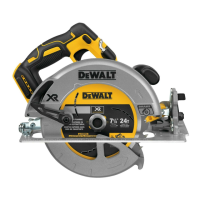14
ENGLISH
pinching in the material. See the section titled Cutting
DepthAdjustment.
3. BLADE TWISTING MISALIGNMENT IN CUT
a. Pushing harder to cut through a knot, a nail or a hard
grain area can cause the blade totwist.
b. Trying to turn the saw in the cut (trying to get back on
the marked line) can cause bladetwist.
c. Overreaching or operating the saw with poor body
control (out of balance), can result in twisting theblade.
d. Changing hand grip or body position while cutting can
result in bladetwist.
e. Backing up the saw to clear blade can lead totwist.
4. MATERIALS THAT REQUIRE EXTRA ATTENTION
a. Wet timber
b. Green timber (material freshly cut or not kiln dried)
c. Pressure treated timber (material treated with
preservatives or anti-rot chemicals)
5. USE OF DULL OR DIRTY BLADES
a. Dull blades cause increased loading of the saw. To
compensate, an operator will usually push harder which
further loads the unit and promotes twisting of the blade
in the kerf. Worn blades may also have insufficient body
clearance which increases the chance of binding and
increasedloading.
6. LIFTING THE SAW WHEN MAKING A BEVEL CUT
a. Bevel cuts require special operator attention to proper
cutting techniques – especially guidance of the saw. Both
blade angle to the base plate and greater blade surface
in the material increase the chance for binding and
misalignment (twist) tooccur.
7. RESTARTING A CUT WITH THE BLADE TEETH JAMMED
AGAINST THE MATERIAL
a. The saw should be brought up to full operating speed
before starting a cut or restarting a cut after the unit has
been stopped with the blade in the kerf. Failure to do so
can cause stalling andkickback.
Any other conditions which could result in pinching, binding,
twisting, or misalignment of the blade could cause kickback.
Refer to the sections Additional Specific Safety Rules for
Circular Saws and Blades for procedures and techniques that
will minimize the occurrence ofkickback.
Depth of Cut Adjustment (Fig.E–F)
1. Raise the depth adjustment lever
4
toloosen.
2. To obtain the correct depth of cut, align the appropriate
mark on the depth adjustment strap
20
with notch
19
on
the upper bladeguard.
3. Tighten the depth adjustmentlever.
4. For the most efficient cutting action using a carbide tipped
saw blade, set the depth adjustment so that about one half
of a tooth projects below the surface of the wood to becut.
5. A method of checking for the correct cutting depth is
shown in FigureF. Lay a piece of the material you plan to
cut along the side of the blade, as shown in the figure, and
observe how much tooth projects beyond thematerial.
Adjusting Depth Adjustment Lever (Fig.E)
It may be desirable to adjust the depth adjustment lever
4
. It
may loosen in time and hit the base plate beforetighten ing.
To Tighten the Lever:
1. Hold depth adjustment lever
4
and loosen the locknut
18
.
2. Adjust the depth adjustment lever by rotating it in the
desired direction about 1/8 of arevolution.
3. Retightennut.
Bevel Angle Adjustment (Fig.A,G)
The bevel angle adjustment mechanism can be adjusted
between 0° and 57°.
To achieve better accuracy in cutting, use the fine adjustment
markings located on the pivot bracket
21
.
1. Raise the bevel adjustment lever
10
toloosen.
2. Tilt the base plate to the desired angle by aligning the fine
bevel pointer
22
with the desired angle mark on the pivot
bracket
21
.
3. Lower the bevel adjustment lever toretighten.
Bevel Detent (Fig.A, G)
The DCS570 is equipped with a bevel detent feature. As you
tilt the base plate
5
you will hear a click and feel the base
plate stop at both 22.5 and 45 degrees. If either of these is the
desired angle, retighten the lever
10
by lowering it. If you
desire another angle, continue tilting the base plate until the
coarse bevel pointer
23
or the fine pointer
22
aligns with the
desiredmark.
Cut Length Indicator (Fig.A)
The markings on the side of the base plate
5
show the length
of the slot being cut into the material at the full depth of the cut.
The markings are in increments of 5mm.
Kerf Indicator (Fig.I)
The front of the saw base plate has a kerf indicator
9
for vertical
and bevel cutting. This indicator enables you to guide the saw
along cutting lines penciled on the material being cut. The kerf
indicator lines up with the left (outer) side of the saw blade,
which makes the slot or “kerf” cut by the moving blade fall to
the right of the indicator. Guide along the penciled cutting line
so that the kerf falls into the waste or surplus material.
Mounting and Adjusting the Parallel Fence
(Fig.N)
The parallel fence
28
is used for cutting parallel to the edge of
theworkpiece.
Mounting
1. Slacken the parallel fence adjustment knob
27
to allow the
parallel fence topass.
2. Insert the parallel fence
28
in the base plate asshown.
3. Tighten the parallel fence adjustment knob
27
.

